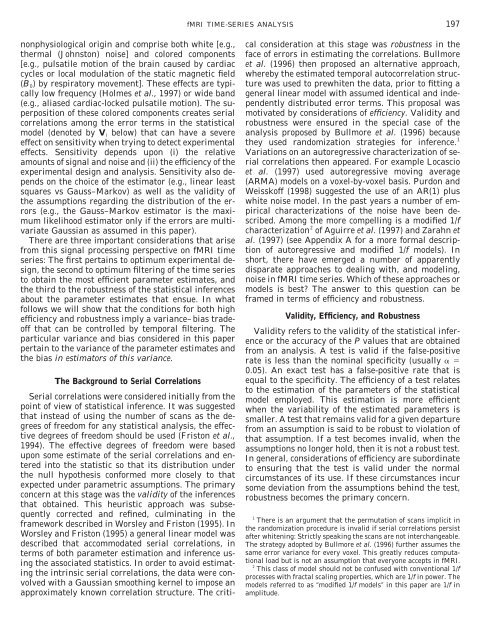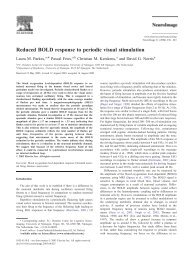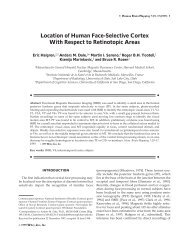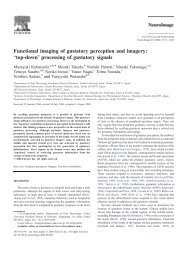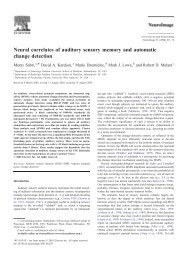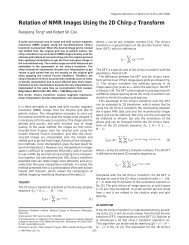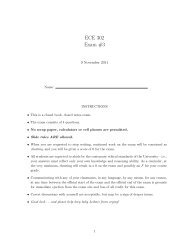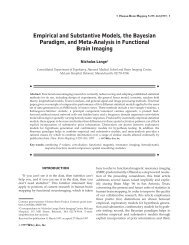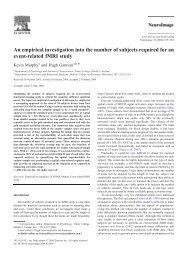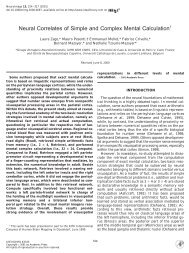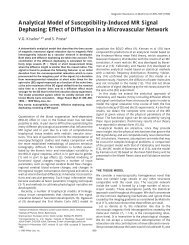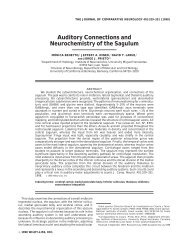Bias and Efficiency in fMRI Time-Series Analysis - Purdue University
Bias and Efficiency in fMRI Time-Series Analysis - Purdue University
Bias and Efficiency in fMRI Time-Series Analysis - Purdue University
Create successful ePaper yourself
Turn your PDF publications into a flip-book with our unique Google optimized e-Paper software.
<strong>fMRI</strong> TIME-SERIES ANALYSIS<br />
197<br />
nonphysiological orig<strong>in</strong> <strong>and</strong> comprise both white [e.g.,<br />
thermal (Johnston) noise] <strong>and</strong> colored components<br />
[e.g., pulsatile motion of the bra<strong>in</strong> caused by cardiac<br />
cycles or local modulation of the static magnetic field<br />
(B 0 ) by respiratory movement]. These effects are typically<br />
low frequency (Holmes et al., 1997) or wide b<strong>and</strong><br />
(e.g., aliased cardiac-locked pulsatile motion). The superposition<br />
of these colored components creates serial<br />
correlations among the error terms <strong>in</strong> the statistical<br />
model (denoted by V i below) that can have a severe<br />
effect on sensitivity when try<strong>in</strong>g to detect experimental<br />
effects. Sensitivity depends upon (i) the relative<br />
amounts of signal <strong>and</strong> noise <strong>and</strong> (ii) the efficiency of the<br />
experimental design <strong>and</strong> analysis. Sensitivity also depends<br />
on the choice of the estimator (e.g., l<strong>in</strong>ear least<br />
squares vs Gauss–Markov) as well as the validity of<br />
the assumptions regard<strong>in</strong>g the distribution of the errors<br />
(e.g., the Gauss–Markov estimator is the maximum<br />
likelihood estimator only if the errors are multivariate<br />
Gaussian as assumed <strong>in</strong> this paper).<br />
There are three important considerations that arise<br />
from this signal process<strong>in</strong>g perspective on <strong>fMRI</strong> time<br />
series: The first perta<strong>in</strong>s to optimum experimental design,<br />
the second to optimum filter<strong>in</strong>g of the time series<br />
to obta<strong>in</strong> the most efficient parameter estimates, <strong>and</strong><br />
the third to the robustness of the statistical <strong>in</strong>ferences<br />
about the parameter estimates that ensue. In what<br />
follows we will show that the conditions for both high<br />
efficiency <strong>and</strong> robustness imply a variance–bias tradeoff<br />
that can be controlled by temporal filter<strong>in</strong>g. The<br />
particular variance <strong>and</strong> bias considered <strong>in</strong> this paper<br />
perta<strong>in</strong> to the variance of the parameter estimates <strong>and</strong><br />
the bias <strong>in</strong> estimators of this variance.<br />
The Background to Serial Correlations<br />
Serial correlations were considered <strong>in</strong>itially from the<br />
po<strong>in</strong>t of view of statistical <strong>in</strong>ference. It was suggested<br />
that <strong>in</strong>stead of us<strong>in</strong>g the number of scans as the degrees<br />
of freedom for any statistical analysis, the effective<br />
degrees of freedom should be used (Friston et al.,<br />
1994). The effective degrees of freedom were based<br />
upon some estimate of the serial correlations <strong>and</strong> entered<br />
<strong>in</strong>to the statistic so that its distribution under<br />
the null hypothesis conformed more closely to that<br />
expected under parametric assumptions. The primary<br />
concern at this stage was the validity of the <strong>in</strong>ferences<br />
that obta<strong>in</strong>ed. This heuristic approach was subsequently<br />
corrected <strong>and</strong> ref<strong>in</strong>ed, culm<strong>in</strong>at<strong>in</strong>g <strong>in</strong> the<br />
framework described <strong>in</strong> Worsley <strong>and</strong> Friston (1995). In<br />
Worsley <strong>and</strong> Friston (1995) a general l<strong>in</strong>ear model was<br />
described that accommodated serial correlations, <strong>in</strong><br />
terms of both parameter estimation <strong>and</strong> <strong>in</strong>ference us<strong>in</strong>g<br />
the associated statistics. In order to avoid estimat<strong>in</strong>g<br />
the <strong>in</strong>tr<strong>in</strong>sic serial correlations, the data were convolved<br />
with a Gaussian smooth<strong>in</strong>g kernel to impose an<br />
approximately known correlation structure. The critical<br />
consideration at this stage was robustness <strong>in</strong> the<br />
face of errors <strong>in</strong> estimat<strong>in</strong>g the correlations. Bullmore<br />
et al. (1996) then proposed an alternative approach,<br />
whereby the estimated temporal autocorrelation structure<br />
was used to prewhiten the data, prior to fitt<strong>in</strong>g a<br />
general l<strong>in</strong>ear model with assumed identical <strong>and</strong> <strong>in</strong>dependently<br />
distributed error terms. This proposal was<br />
motivated by considerations of efficiency. Validity <strong>and</strong><br />
robustness were ensured <strong>in</strong> the special case of the<br />
analysis proposed by Bullmore et al. (1996) because<br />
they used r<strong>and</strong>omization strategies for <strong>in</strong>ference. 1<br />
Variations on an autoregressive characterization of serial<br />
correlations then appeared. For example Locascio<br />
et al. (1997) used autoregressive mov<strong>in</strong>g average<br />
(ARMA) models on a voxel-by-voxel basis. Purdon <strong>and</strong><br />
Weisskoff (1998) suggested the use of an AR(1) plus<br />
white noise model. In the past years a number of empirical<br />
characterizations of the noise have been described.<br />
Among the more compell<strong>in</strong>g is a modified 1/f<br />
characterization 2 of Aguirre et al. (1997) <strong>and</strong> Zarahn et<br />
al. (1997) (see Appendix A for a more formal description<br />
of autoregressive <strong>and</strong> modified 1/f models). In<br />
short, there have emerged a number of apparently<br />
disparate approaches to deal<strong>in</strong>g with, <strong>and</strong> model<strong>in</strong>g,<br />
noise <strong>in</strong> <strong>fMRI</strong> time series. Which of these approaches or<br />
models is best? The answer to this question can be<br />
framed <strong>in</strong> terms of efficiency <strong>and</strong> robustness.<br />
Validity, <strong>Efficiency</strong>, <strong>and</strong> Robustness<br />
Validity refers to the validity of the statistical <strong>in</strong>ference<br />
or the accuracy of the P values that are obta<strong>in</strong>ed<br />
from an analysis. A test is valid if the false-positive<br />
rate is less than the nom<strong>in</strong>al specificity (usually <br />
0.05). An exact test has a false-positive rate that is<br />
equal to the specificity. The efficiency of a test relates<br />
to the estimation of the parameters of the statistical<br />
model employed. This estimation is more efficient<br />
when the variability of the estimated parameters is<br />
smaller. A test that rema<strong>in</strong>s valid for a given departure<br />
from an assumption is said to be robust to violation of<br />
that assumption. If a test becomes <strong>in</strong>valid, when the<br />
assumptions no longer hold, then it is not a robust test.<br />
In general, considerations of efficiency are subord<strong>in</strong>ate<br />
to ensur<strong>in</strong>g that the test is valid under the normal<br />
circumstances of its use. If these circumstances <strong>in</strong>cur<br />
some deviation from the assumptions beh<strong>in</strong>d the test,<br />
robustness becomes the primary concern.<br />
1 There is an argument that the permutation of scans implicit <strong>in</strong><br />
the r<strong>and</strong>omization procedure is <strong>in</strong>valid if serial correlations persist<br />
after whiten<strong>in</strong>g: Strictly speak<strong>in</strong>g the scans are not <strong>in</strong>terchangeable.<br />
The strategy adopted by Bullmore et al. (1996) further assumes the<br />
same error variance for every voxel. This greatly reduces computational<br />
load but is not an assumption that everyone accepts <strong>in</strong> <strong>fMRI</strong>.<br />
2 This class of model should not be confused with conventional 1/f<br />
processes with fractal scal<strong>in</strong>g properties, which are 1/f <strong>in</strong> power. The<br />
models referred to as “modified 1/f models” <strong>in</strong> this paper are 1/f <strong>in</strong><br />
amplitude.


